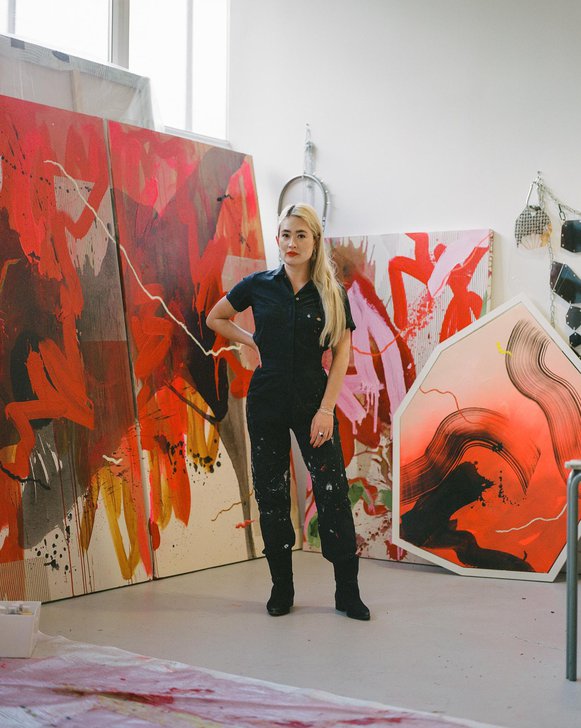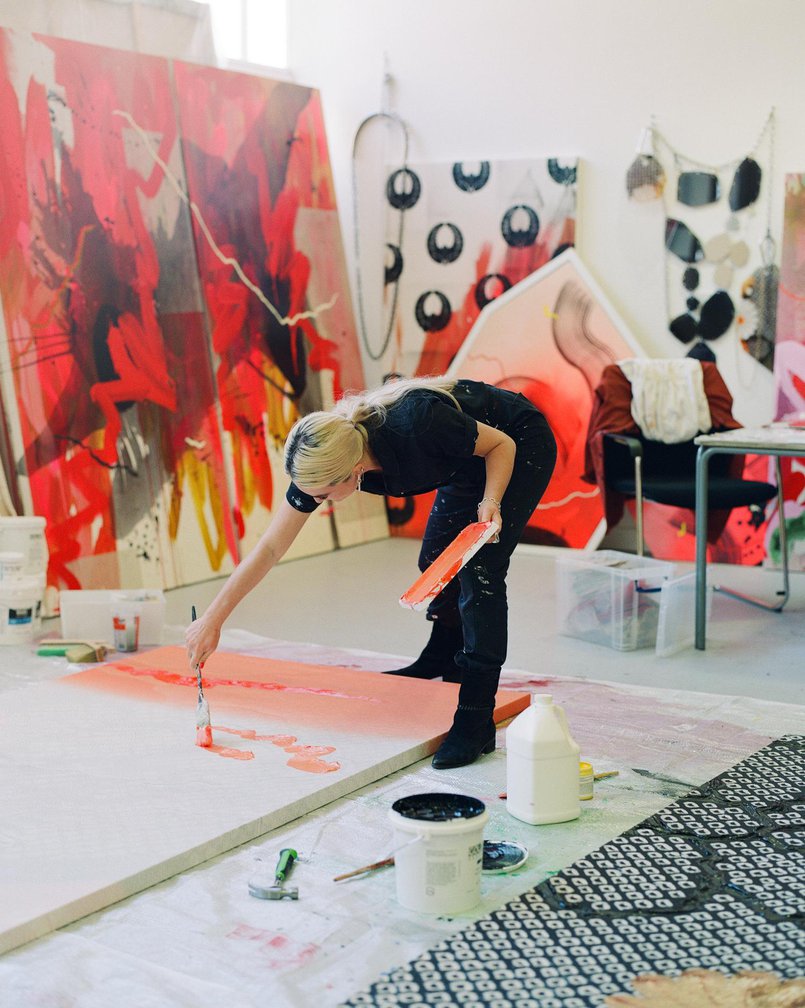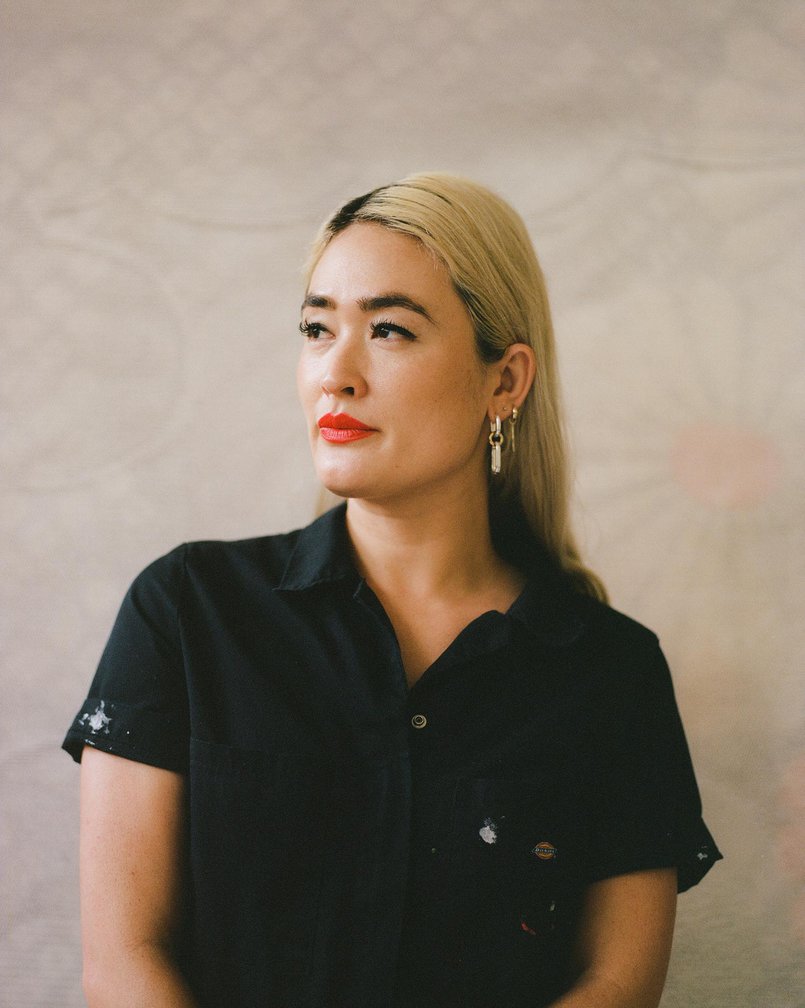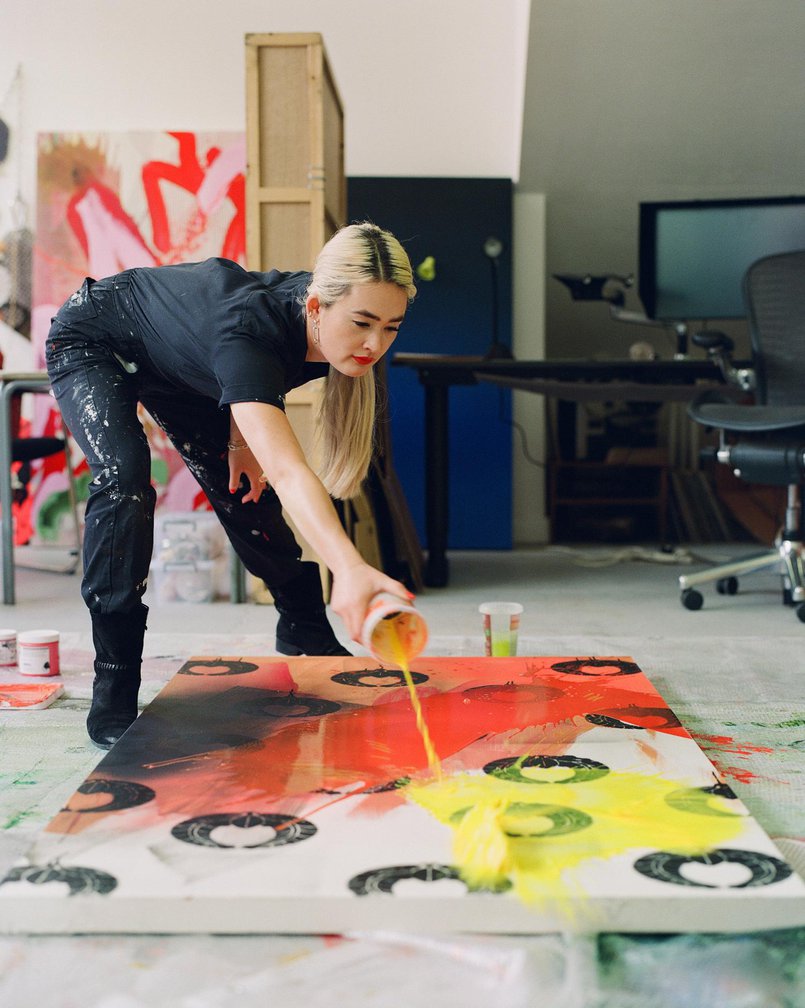article In conversation with
Makiko Harris
In conversation with
Makiko Harris
Makiko Harris

In conversation with Makiko Harris
about the physical process of making
work and using a daily experience of
ambiguity as influence.
about the physical process of making
work and using a daily experience of
ambiguity as influence.
In conversation with Makiko Harris
about the physical process of making
work and using a daily experience of
ambiguity as influence.
Makiko Harris is a multidisciplinary artist from San Fransisco working across painting, sculpture and installation, exploring themes of gender, identity and structures of power.
Having studied a BA in Philosophy and Art at Tufts University, Boston, Makiko's work is highly informed by feminist theory and her personal experiences as a biracial woman. Throughout her practice, she challenges viewers to think critically about their roles and societal power dynamics.
We're incredibly proud to have sixteen paintings by Makiko currently in our catalogue, which utilise bold, gestural brushstrokes and evocative marks. The use of colour within these works is influenced by research into the concept of the 'monstrous-feminine'. For example, vermillion red in Japan is the colour of sacred temples, as well as the lipstick worn by geisha. However, the same colour was originally created with toxic mercury in the West. The 'gem' polygon shape is also a frequent recurrence within Makiko's practice, both within her 'Gem Series' in our Artiq catalogue and her recent installation 'Glass Ceiling'. These shapes explore the fragmentation and reconfiguration of identity, appearing in numerous different colour variations, materials and forms.
Earlier this year, we had the pleasure of working with Makiko on a series of bespoke commissioned paintings for a high-end restaurant in central London. Catching up recently, we finally had the pleasure of learning about the physical process of making her work and using a daily experience of ambiguity as an influence.
Having studied a BA in Philosophy and Art at Tufts University, Boston, Makiko's work is highly informed by feminist theory and her personal experiences as a biracial woman. Throughout her practice, she challenges viewers to think critically about their roles and societal power dynamics.
We're incredibly proud to have sixteen paintings by Makiko currently in our catalogue, which utilise bold, gestural brushstrokes and evocative marks. The use of colour within these works is influenced by research into the concept of the 'monstrous-feminine'. For example, vermillion red in Japan is the colour of sacred temples, as well as the lipstick worn by geisha. However, the same colour was originally created with toxic mercury in the West. The 'gem' polygon shape is also a frequent recurrence within Makiko's practice, both within her 'Gem Series' in our Artiq catalogue and her recent installation 'Glass Ceiling'. These shapes explore the fragmentation and reconfiguration of identity, appearing in numerous different colour variations, materials and forms.
Earlier this year, we had the pleasure of working with Makiko on a series of bespoke commissioned paintings for a high-end restaurant in central London. Catching up recently, we finally had the pleasure of learning about the physical process of making her work and using a daily experience of ambiguity as an influence.

Artiq You work with a multitude of materials and experiment across different mediums. How do these materials inform your artistic research and how do they relate to your personal history?
Makiko In my current practice the materials don’t inform the research, it’s the other way around. My research informs what materials I choose. For example, when my grandparents in Japan passed away and we sold their house last year, I inherited objects from their life such as a sewing basket, kimonos, pottery. It got me thinking about what we inherit not only from our families of origin, but also more generally from our culture about expectations and assumptions about identity. I wanted to turn the tools my grandmother used to express her own identity and agency, sewing needles, on their head. The works are enlarged metal replicas of sewing and knitting needles. They are simple, and I hope they have a quiet, confident presence without needing to be too much more than exactly what they are. Metal was the obvious choice for this work in its connection to the original objects of inspiration as well as in its weight and relation to weaponry.
Artiq Your work explores, amongst other themes, women’s agency. How does this research intertwine with your creative process?
Makiko While my work is certainly informed by a feminist perspective, based on my background in feminist philosophy, I am most interested in agency in general for all persons. This includes how factors like family, heritage, culture, or even internalised pressures might change how agency is able to be expressed. I think the classical image of a white male artist making gigantic abstract paintings is all about expressing voice and agency. Bringing this to the contemporary moment, what does it mean for a woman of ambiguous subjectivity to do the same thing?
Makiko In my current practice the materials don’t inform the research, it’s the other way around. My research informs what materials I choose. For example, when my grandparents in Japan passed away and we sold their house last year, I inherited objects from their life such as a sewing basket, kimonos, pottery. It got me thinking about what we inherit not only from our families of origin, but also more generally from our culture about expectations and assumptions about identity. I wanted to turn the tools my grandmother used to express her own identity and agency, sewing needles, on their head. The works are enlarged metal replicas of sewing and knitting needles. They are simple, and I hope they have a quiet, confident presence without needing to be too much more than exactly what they are. Metal was the obvious choice for this work in its connection to the original objects of inspiration as well as in its weight and relation to weaponry.
Artiq Your work explores, amongst other themes, women’s agency. How does this research intertwine with your creative process?
Makiko While my work is certainly informed by a feminist perspective, based on my background in feminist philosophy, I am most interested in agency in general for all persons. This includes how factors like family, heritage, culture, or even internalised pressures might change how agency is able to be expressed. I think the classical image of a white male artist making gigantic abstract paintings is all about expressing voice and agency. Bringing this to the contemporary moment, what does it mean for a woman of ambiguous subjectivity to do the same thing?

Artiq Your large-scale paintings are the result of a physically demanding process of creation. Can you tell us a bit more about your experience undertaking such labour-intensive projects?
Makiko The physical process of making is pivotal to my work as an artist and to managing myself personally. I have a lot of energy and have trouble being still. Making big things calms me; I externalise the existential anxiety. The physicality also informs how I work overall, because my body responds to the work as it’s being made. For example, I might have a sketch or an idea of a project, but then as I’m making it and start to see it physically in space, I observe how my body responds to the work. Does it feel settled? Balanced? Slightly uncomfortable? Based on my body’s response, I adjust the work until it feels right for the intention of the piece. My MA dissertation which I wrote at the Royal College of Art, Limitlessness in the Tactile Encounter: Embodied Subjectivity in Art Practice, discussed this physical relationship between the artist and their work from a philosophical perspective. I work in this embodied way regardless of the medium or the conceptual context of the work.
Artiq You have a background in Philosophy and in particular in Feminist Philosophy and Aesthetics; can you elaborate on the influence and contribution these studies have to your practice?
Makiko I studied Philosophy and Art in my B.A. at Tufts University in Boston, and this background deeply informs my perspective on aesthetic and objecthood. In our current moment, I often observe that there is a stance in academic critique that distrusts or devalues beauty. To be frank, I think that is just patriarchy. I am bored by people who dismiss aesthetics in art. Enjoying beauty is pleasurable and pleasure is important, it makes us human. If we move away from a logic-centric patriarchal consideration of artwork where concept has more value than aesthetics, and we open the definition of beauty to be inclusive of a multiplicity of subjectivities and contradictory perspectives, I think making work that is aesthetically pleasurable becomes radical in a feminist, somatically oriented way.
Makiko The physical process of making is pivotal to my work as an artist and to managing myself personally. I have a lot of energy and have trouble being still. Making big things calms me; I externalise the existential anxiety. The physicality also informs how I work overall, because my body responds to the work as it’s being made. For example, I might have a sketch or an idea of a project, but then as I’m making it and start to see it physically in space, I observe how my body responds to the work. Does it feel settled? Balanced? Slightly uncomfortable? Based on my body’s response, I adjust the work until it feels right for the intention of the piece. My MA dissertation which I wrote at the Royal College of Art, Limitlessness in the Tactile Encounter: Embodied Subjectivity in Art Practice, discussed this physical relationship between the artist and their work from a philosophical perspective. I work in this embodied way regardless of the medium or the conceptual context of the work.
Artiq You have a background in Philosophy and in particular in Feminist Philosophy and Aesthetics; can you elaborate on the influence and contribution these studies have to your practice?
Makiko I studied Philosophy and Art in my B.A. at Tufts University in Boston, and this background deeply informs my perspective on aesthetic and objecthood. In our current moment, I often observe that there is a stance in academic critique that distrusts or devalues beauty. To be frank, I think that is just patriarchy. I am bored by people who dismiss aesthetics in art. Enjoying beauty is pleasurable and pleasure is important, it makes us human. If we move away from a logic-centric patriarchal consideration of artwork where concept has more value than aesthetics, and we open the definition of beauty to be inclusive of a multiplicity of subjectivities and contradictory perspectives, I think making work that is aesthetically pleasurable becomes radical in a feminist, somatically oriented way.

Artiq How does your work challenge fixed identities outlined within patriarchal and racialized structures? Are there specific artworks or projects that exemplify this exploration?
Makiko I was born to a white American father and a native Japanese mother. I engage with the world from a position that is ambiguous and multiple. My practice is informed by my daily experience with this ambiguity. For example, in majority white countries I am usually identified as Asian, and in majority Asian countries I am typically identified as white. As a living contradiction, my work seeks to dismantle assumptions of fixed identity through works that confront the viewer with an awareness of contradictions within themselves.
For example, I intend for my kimono paintings to sit at an uncomfortable edge between pleasure in the aesthetic of the other (one could call this fetish), while the scale, irreverent use of a family crest, and interruptions in pattern by my hand and eye could be seen as irreverent or even veering into cultural appropriation. Through the use of the kimono, I intend to ask viewers to contemplate how their perspective informs how they see the work. Do they see a beautiful pattern of exquisite craft, do they see a disrespectful use of cultural heritage, or do you see an ambiguous interpretation of both? Can we exist beyond fixed categories of identity?
Artiq Are you currently working on something new? If so, can you share any upcoming projects or exhibitions that we can look forward to? Are there any particular ideas or concepts you are excited to explore in your future work?
Makiko I am always working! My next exhibit is in Hiroshima, Japan in October 2023 where I will be presenting a series of 7 kimono paintings alongside a collective of 2 other artists. This winter, I’m really looking forward to getting back to some deep work in painting in the studio. Beyond that, I have some exciting projects coming up in London, Brighton, and San Francisco, CA that are still under wraps but will include more sculpture, installation, and sound work. If you’d like to stay connected, follow me on Instagram or sign up for my mailing list for infrequent updates.
Makiko I was born to a white American father and a native Japanese mother. I engage with the world from a position that is ambiguous and multiple. My practice is informed by my daily experience with this ambiguity. For example, in majority white countries I am usually identified as Asian, and in majority Asian countries I am typically identified as white. As a living contradiction, my work seeks to dismantle assumptions of fixed identity through works that confront the viewer with an awareness of contradictions within themselves.
For example, I intend for my kimono paintings to sit at an uncomfortable edge between pleasure in the aesthetic of the other (one could call this fetish), while the scale, irreverent use of a family crest, and interruptions in pattern by my hand and eye could be seen as irreverent or even veering into cultural appropriation. Through the use of the kimono, I intend to ask viewers to contemplate how their perspective informs how they see the work. Do they see a beautiful pattern of exquisite craft, do they see a disrespectful use of cultural heritage, or do you see an ambiguous interpretation of both? Can we exist beyond fixed categories of identity?
Artiq Are you currently working on something new? If so, can you share any upcoming projects or exhibitions that we can look forward to? Are there any particular ideas or concepts you are excited to explore in your future work?
Makiko I am always working! My next exhibit is in Hiroshima, Japan in October 2023 where I will be presenting a series of 7 kimono paintings alongside a collective of 2 other artists. This winter, I’m really looking forward to getting back to some deep work in painting in the studio. Beyond that, I have some exciting projects coming up in London, Brighton, and San Francisco, CA that are still under wraps but will include more sculpture, installation, and sound work. If you’d like to stay connected, follow me on Instagram or sign up for my mailing list for infrequent updates.